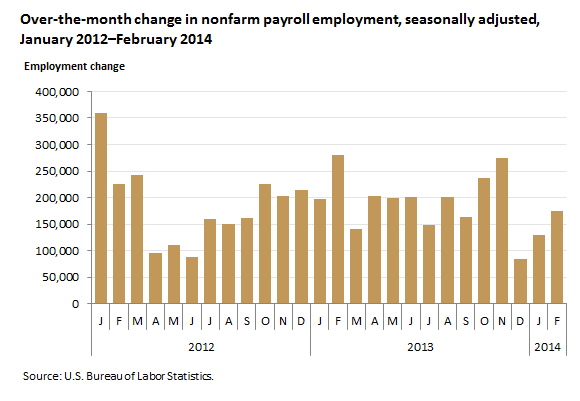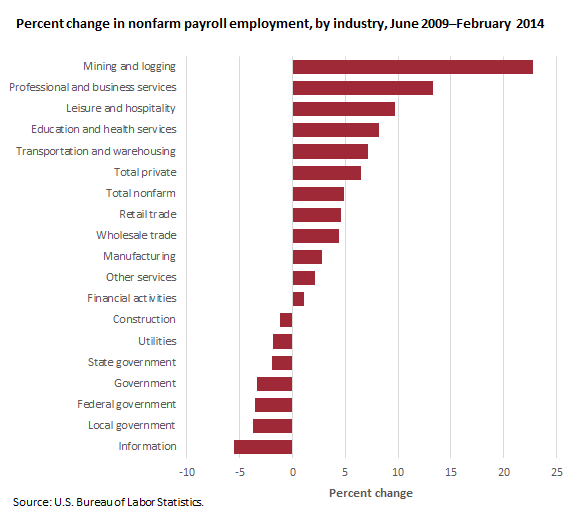An official website of the United States government
 United States Department of Labor
United States Department of Labor
Total nonfarm payroll employment rose by 175,000 in February. Job growth averaged 189,000 per month over the prior 12 months. In February, job gains occurred in professional and business services and in wholesale trade, while the information industry lost jobs.

| Month | Employment change |
|---|---|
January 2012 | 360,000 |
February 2012 | 226,000 |
March 2012 | 243,000 |
April 2012 | 96,000 |
May 2012 | 110,000 |
June 2012 | 88,000 |
July 2012 | 160,000 |
August 2012 | 150,000 |
September 2012 | 161,000 |
October 2012 | 225,000 |
November 2012 | 203,000 |
December 2012 | 214,000 |
January 2013 | 197,000 |
February 2013 | 280,000 |
March 2013 | 141,000 |
April 2013 | 203,000 |
May 2013 | 199,000 |
June 2013 | 201,000 |
July 2013 | 149,000 |
August 2013 | 202,000 |
September 2013 | 164,000 |
October 2013 | 237,000 |
November 2013 | 274,000 |
December 2013 | 84,000 |
January 2014 | 129,000(p) |
February 2014 | 175,000(p) |
| Footnotes:
(p) preliminary
| |
Employment in professional and business services increased by 79,000 in February. Over the prior 12 months, professional and business services added an average of 56,000 jobs per month. Accounting and bookkeeping services added 16,000 jobs in February. Employment continued to trend up in temporary help services (+24,000) and in services to buildings and dwellings (+11,000).
In February, wholesale trade added 15,000 jobs, with nearly all of the increase occurring in durable goods (+12,000). Over the prior 12 months, the employment gain in wholesale trade averaged 9,000 per month.
The information industry lost 16,000 jobs in February. Most of the decline occurred in motion picture and sound recording (-14,000); employment in this industry can be volatile from month to month.
Employment in other major industries changed little over the month.
Since the most recent recession ended in June 2009, total nonfarm payroll employment has increased 4.9 percent. Employment in the private sector increased 6.5 percent from June 2009 to February 2014, while government employment declined 3.3 percent.

| Industry | Employment level | Percent change | |
|---|---|---|---|
| June 2009 | February 2014(p) | ||
Total nonfarm | 130,944,000 | 137,699,000 | 4.9 |
Total private | 108,368,000 | 115,848,000 | 6.5 |
Mining and logging | 686,000 | 888,000 | 22.7 |
Construction | 6,010,000 | 5,941,000 | -1.2 |
Manufacturing | 11,726,000 | 12,065,000 | 2.8 |
Wholesale trade | 5,577,400 | 5,832,100 | 4.4 |
Retail trade | 14,536,800 | 15,235,000 | 4.6 |
Transportation and warehousing | 4,233,800 | 4,560,200 | 7.2 |
Utilities | 560,100 | 549,900 | -1.9 |
Information | 2,796,000 | 2,650,000 | -5.5 |
Financial activities | 7,821,000 | 7,908,000 | 1.1 |
Professional and business services | 16,436,000 | 18,963,000 | 13.3 |
Education and health services | 19,537,000 | 21,285,000 | 8.2 |
Leisure and hospitality | 13,076,000 | 14,482,000 | 9.7 |
Other services | 5,372,000 | 5,489,000 | 2.1 |
Government | 22,576,000 | 21,851,000 | -3.3 |
Federal government | 2,814,000 | 2,717,000 | -3.6 |
State government | 5,176,000 | 5,076,000 | -2.0 |
Local government | 14,586,000 | 14,058,000 | -3.8 |
(p)=preliminary | |||
Among the major private sector industries, mining and logging experienced the largest employment gain since the end of the recession, 22.7 percent. Employment in professional and business services increased 13.3 percent, while employment in leisure and hospitality rose 9.7 percent. The information industry, utilities, and construction all lost jobs, on net, from June 2009 to February 2014.
These data are from the Current Employment Statistics (CES) program and are seasonally adjusted. Data for the most recent two months are preliminary. To learn more, see "The Employment Situation — February 2014," (HTML) (PDF) news release USDL‑14‑0354. More charts featuring CES employment data can be found in Current Employment Statistics Highlights: February 2014 (PDF).
Bureau of Labor Statistics, U.S. Department of Labor, The Economics Daily, Payroll employment up 175,000 in February 2014 at https://www.bls.gov/opub/ted/2014/ted_20140310.htm (visited December 18, 2025).

